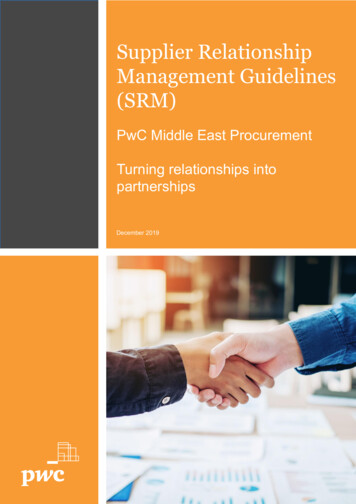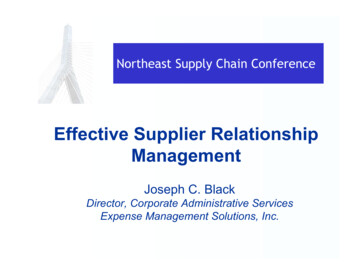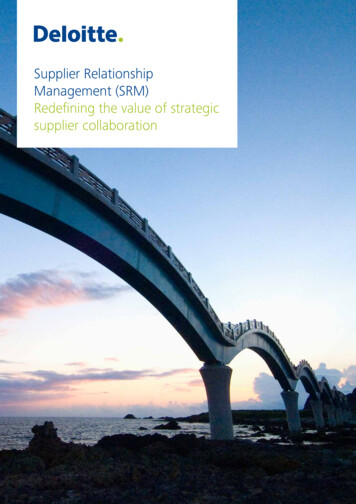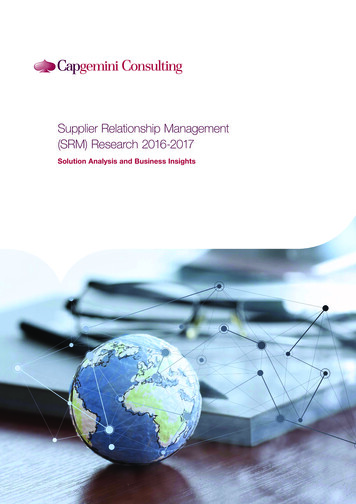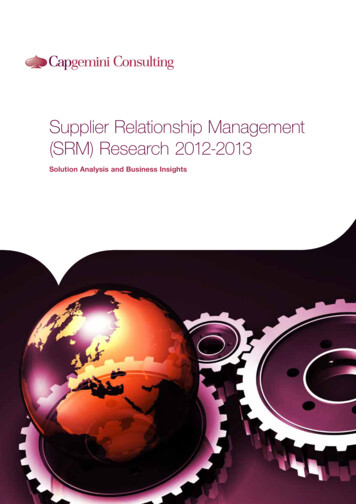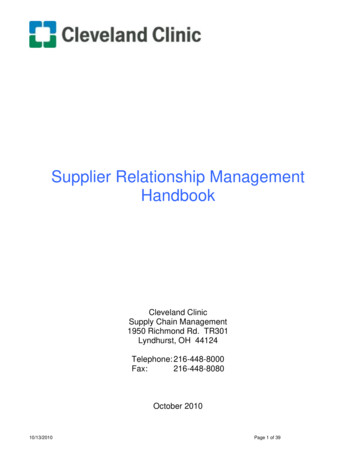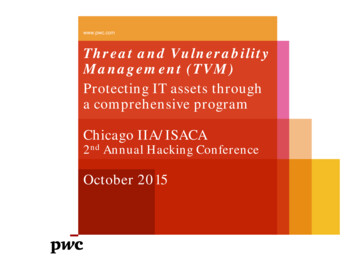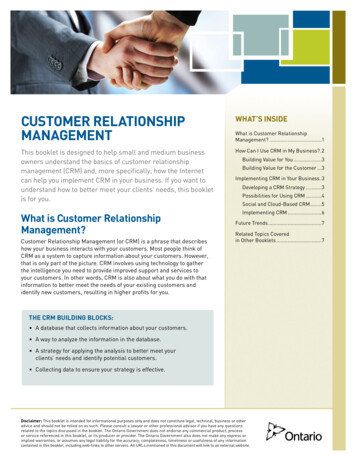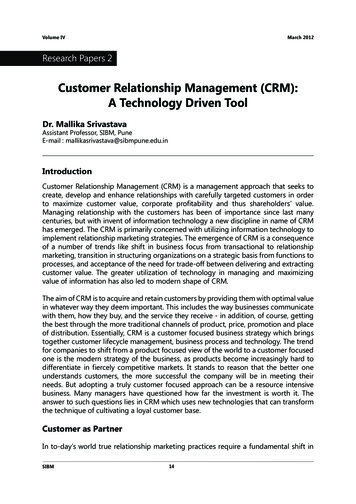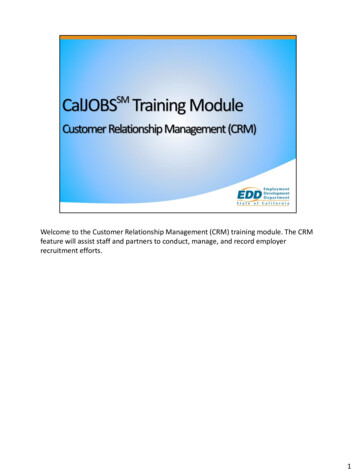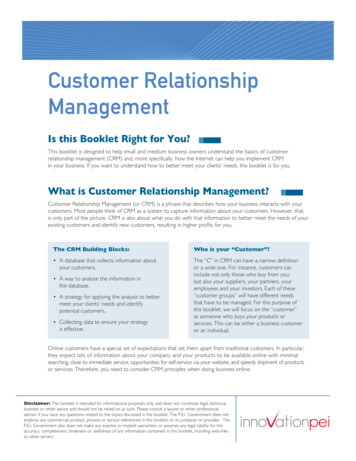
Transcription
Supplier RelationshipManagementHow key suppliersdrive your company’scompetitive advantage
At PwC in the Netherlands over 4,600 people work together from 12 offices and three different perspectives:Assurance, Tax & HRS and Advisory. We provide industry-focused services and search for surprising solutions,not only for national and international companies but also for public sector and civil-society organisations.PwC firms provide industry-focused assurance, tax and advisory services to enhance value for their clients. Morethan 169,000 people in 158 countries in firms across the PwC network share their thinking, experience andsolutions to develop fresh perspectives and practical advice.2
ForewordNearly all self-respecting procurement organisations have a stated intent andcommitment to do more in the area of supplier relationship management. And for allthe right reasons: Without SRM, negotiated savings may never be realised, The business might consider procurement “missing in action” when something goeswrong, and Suppliers may begin to see procurement as just negotiating, i.e. not involved in thereal business. As a result, they might not make their best effort going forward, letalone be proactive in offering innovative suggestions.Remko van HoekGlobal ProcurementDirector PwC & VisitingProfessor CranfieldSchool of ManagementThe call to do more with SRM is not new, so isn’t it about time we actually started doingmore and talking less? The answer is yes, but the process is not easy and some help andinput on the following could be valuable: The capabilities and composition of the procurement team might need to change, The team’s orientation may need to be adapted (with a view to primarily selling thecompany to suppliers to get the best inputs first), Time allocation could need tweaking (e.g., spending more time with suppliers thanwith the procurement team), and Roles and engagement with internal stakeholders might need a review (essentially,inserting procurement into a business-centric relationship).Put simply, being able to negotiate a deal does not mean a buyer is able to manage arelationship, nor is it possible to ensure premium access to suppliers in a contract. Soour team and our toolkit need work.We initiated a study to gain a better understanding of SRM and to advise our clients onthis topic. The value of this study for procurement leaders is many-fold: It informs our understanding of what is keeping us from doing more in the area ofSRM, It offers practical perspectives and insights that can enhance our action planning, Because the study is based on discussions with our peers, expert interviews and aonline survey, it is not theory centric or wishful thinking; it is about real-life lessonsfrom the market, Finally, it is part of our team’s ongoing effort to help improving SRM practices withinsight and practical advice.However, our efforts will not end with this report. On the contrary, our work has justbegun. There are lots of opportunities to join the discussion in upcoming roundtablesand further practice development. Do let us know if you would like to get involved andbenefit from the process. The time is ripe for procurement to start doing what it hasbeen meant to do more for a long time. Please use the advice, experience and toolscaptured in this report to your advantage. It is our hope that this will help you on yourSRM journey.3
4
Table of contentsExecutive summary6Introduction71. Key research findings102. Towards world-class SRM183. How to establish SRM36Acknowledgements38About the research team39Appendix 1: Population profile of online survey41Appendix 2: Detailed SRM maturity model425
Executive summaryEnsuring the best prices through strategic sourcing is no longer perceived as astrategic capability of the procurement function. As a result of further outsourcingof non-core competencies, organisations are starting to realise that they havebecome more reliant on suppliers in terms of innovative power, security of supply,corporate social responsibility, and on-going cost savings. Strategic partnershipsare at the top of the corporate agenda of many global organisations and SupplierRelationship Management (SRM) is seen as one of the few remaining procurementtopics that can still make a significant difference. But many organisationsencounter difficulties in initiating, developing and managing partnerships. Inparticular, leadership and soft skills are mentioned as primary reasons for failure,alongside technical & functional competencies. We initiated a study on SRM togain a better understanding of the typical challenges involved and to determinehow supplier capabilities drive competitive advantage.A CPO roundtable, desk research, anonline survey and expert interviewswere input for our research. Below, wesummarise the ten key findings of ourstudy report:1. The most important SRM objectivesare leveraging supplier capabilities,delivering cost savings and reducingsupply risk exposure.2. Approximately 60% of the respondentshave a formal segmentation processin place, with spend size, product/service importance and risk exposureas the most important segmentationdimensions.3. While the benefits of SRM areacknowledged, the average SRMmaturity level is still low.64. The top-three challenges respondentsencounter are an overemphasis oncost reduction, a lack of specificSRM competences and insufficientalignment between the business,procurement and supplier.5. Typical best practices arequantification of benefits and costs(ROI), proactive and two-wayperformance management, anddocumented supplier strategies persegment.6. Benefits measurement, executivesponsorship and strategic coherenceare indicated as the most criticalsuccess factors.7. Technical/functional, relational anddevelopmental competencies must bebalanced and continuously developed.8. Innovation, sustainability, leagilityand resilience are seen as the keydrivers for SRM value creation.9. Current SRM programmesalready contribute to performancemanagement and risk exposurereduction.10. The respondents indicate that thereis a positive correlation between thepresence of SRM and an increasein market share, responsiveness tomarket changes, increased returnon investment and shortening orderfulfilment lead times.
IntroductionProcurement becomesstrategicThe role of the procurement function isdrastically changing in today’s challengingworld. In the past, procurement wasexpected to ensure the timely availabilityof products and services while also beingresponsible for accurately processingtransactions. Economic developmentsduring the 1980s and 1990s promptedcompanies to recognise the potentialcontribution of procurement tomeeting cost-out targets. Through theimplementation of category managementand running strategic sourcing initiatives,procurement was able to rationalise thesupply base and consolidate volumes,resulting in price reductions. Globalsourcing and outsourcing of non-coreactivities became popular as well.However, the procurement function wasstill functionally organised, with littlecollaboration and alignment with otherbusiness functions, which kept the priceorientation alive.During the advent of the Total Cost ofOwnership (TCO) concept, organisationsstarted to realise that a change from afunctional orientation towards processesoptimisation was required, with crossfunctional collaboration. As a result,procurement became the responsibilityof cross-functional teams while itsstrategic importance and recognitionincreased. The procurement function notonly contributed to price reductions, butalso played a crucial role in optimisingtotal lifecycle costs. The next steptowards procurement excellence is toadopt a value-driven orientation withexternal/supplier collaboration as a keycornerstone.BusinessStrategyMore value drivenAccelerate innovationthrough partnershipsReduce carbon footprint andrealise sustainable sourcingImproveavailability ofproducts & servicesDrivemarket and companystandardizationManage risks andcomply to regulationsMore cost drivenMaximisetax benefitsOptimiseworking capitalRun efficientprocessesReducespend on direct andindirect categoriesEncourage visibility inthe supply chainA Procurement Strategy is developed with the objective of impacting and supporting theBusiness Strategy and is, therefore, fully business driven.As stated previously, ensuring the bestprices through strategic sourcing is nolonger perceived as a strategic capabilityof the procurement function. As a resultof further outsourcing of non-corecompetencies, the procurement costs asa percentage of total cost is 50-80% forcompanies that develop, manufacture,trade and/or distribute goods. Besidesthis financial impact, organisations arestarting to realise that they have becomemore reliant on suppliers in terms ofinnovative power, security of supply,corporate social responsibility, anddelivering on-going cost savings. Togetherwith sustainability, strategic partnering isat the top of the corporate agenda of manyglobal organisations and is seen as one offew remaining procurement topics thatcan still make a significant difference.External integration: nextstep towards procurementexcellenceCompanies are now aware that they mustintegrate and collaborate with suppliersto remain competitive and take the nextstep towards procurement excellence.Supplier management is not a new topic,but it has always been the ‘stepchild’of the procurement function. KPIs likespend reduction were an importantculprit here. Companies became ratherproficient and mature in runningstrategic sourcing initiatives and created“money on the table”. After realisingthe contracted savings, category teamsand buyers jumped on the followingsourcing initiative while neglectingthe implementation and management“Besides risks, we need to financially materialize thecontribution of innovation and sustainability”7
of contracts. Delivering “money in thepocket” reflected as savings in the P&Lappeared to be another story. Researchindicates that there is an average of 25%contract value leakage (“money in theair”). Formalising contract managementand delivering “performance to contract”is a challenge for many organisations.Not every supplier is qualified as a partner:supplier segmentation is necessary todifferentiate supplier strategies. If a supplieris qualified as strategic, an organisation candecide to initiate a partnership.In our definition, Supplier RelationshipManagement (SRM) is a systematicapproach for developing and managingpartnerships. It is focused on joint growthand value creation with a limited numberof key suppliers based on trust, opencommunication, empathy and a winwin orientation. Non-partnerships aremanaged by means of other measureslike contract administration, contractmanagement and vendor rating. In ouropinion, Monczka e.a. (CAPS Research,2011) described the SRM objectives andbenefits very concisely:Value Orientation:InternalValue Orientation:ExternalValueSRM driven byinnovation,sustainabilityand leagility“Value creation:beyondtraditional costcutting”Breakthrough inoperational & financialperformance“Money in the air”Impact of ContractManagement“Money in thepocket”No contractmanagement“Money on thetable”TimeImpact of Strategic Sourcing8Impact of SupplierRelationship Management1. Become ‘customer of choice’:preferential treatment regardingavailability, costs, access totechnology, innovation and riskreduction2. Focus on value: increased marketcompetitiveness through considerationof all relevant elements that determinestakeholder value3. Leverage on supplier capabilities:advantageous position through earlyinvolvement in the innovation andproduct & process developmentprocesses4. Share growth, profits, risks andinvestments: joint objectives, effortsand resource commitments resultingin a healthy culture for continuousgrowth
Research objectives andapproachWith more than 500 sourcing &procurement practitioners worldwide,we have broad and deep expertiseto support organisations in solvingsupply-related issues. We have noticedthat many organisations encounterdifficulties in initiating, developingand managing partnerships. And as wementioned, besides technical & functionalcompetencies, leadership and soft skillswere mentioned as main reasons forfailure. We initiated this study on SRM toget a better understanding of the typicalchallenges and to determine how suppliercapabilities drive competitive advantage.Our research focused on privatecompanies that develop, manufacture,trade and/or deliver goods. The majorityof the participating companies areheadquartered in the Netherlands. Toachieve our goal, we wanted answers tothe following research questions: How is SRM currently structured atprivate sector organisations? Which key challenges do organisationsencounter in building strategicpartnerships? Which best practices can be adopted toachieve world-class SRM? Which supplier capabilities drivecompetitive advantage? How can organisations successfullyimplement SRM?The research team deployed severalresearch methods to collect observations,draw conclusions and definerecommendations. After several initialinterviews with business executives andprofessors, we decided to organise aCPO Round Table to further elaborate onSRM. We also took this opportunity todefine hypotheses. Next, we performedextensive desk research (PwC andnon-PwC sources), which we used asa basis for developing and launchingan online survey. The results of theonline survey and case studies servedto validate the hypotheses. This reportpresents our observations, conclusionsand recommendations. It is important tonote that our database is growing becauseorganisations are still contributing bymeans of the online survey.Phase IV:Expert interviewsPhase II:Desk ResearchCPO Round Tableto explore topicand definehypothesePhase I:CPO Round TableExtensiveliterature reviewto buildfoundation forresearchThis report is structured in three chapters.Chapter 1 presents current SRM
Supplier Relationship Management How key suppliers drive your company’s competitive advantage. At PwC in the Netherlands over 4,600 people work together from 12 offices and three different perspectives: Assurance, Tax & HRS and Advisory. We provide industry-focused services and search for surprising solutions, not only for national and international companies but also for public sector and .File Size: 1MBPage Count: 44Explore furtherSupplier Relationship Management (SRM) Identifying and .www2.deloitte.comThe five secrets of supplier relationship management .www.cips.orgEffective Supplier Relationship Managementwww.nescon.orgSupplier Relationship Management - Four Pillars4pillars.orgStrategic Supplier Management - Infosys BPMwww.infosysbpm.comRecommended to you based on what's popular Feedback
